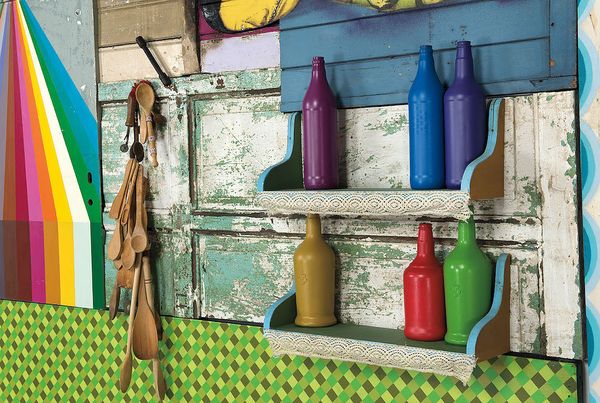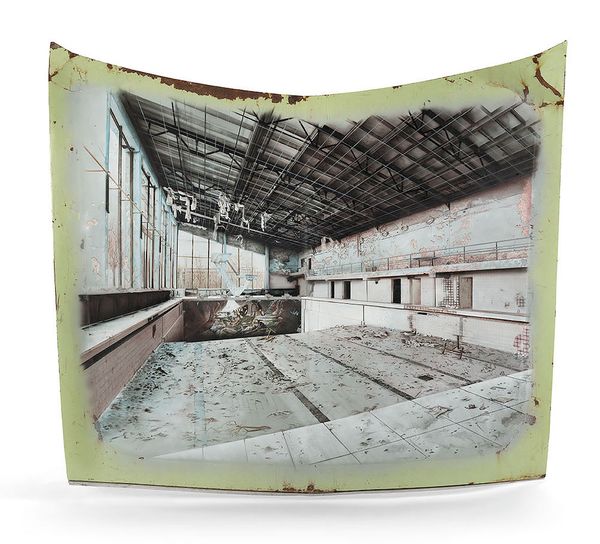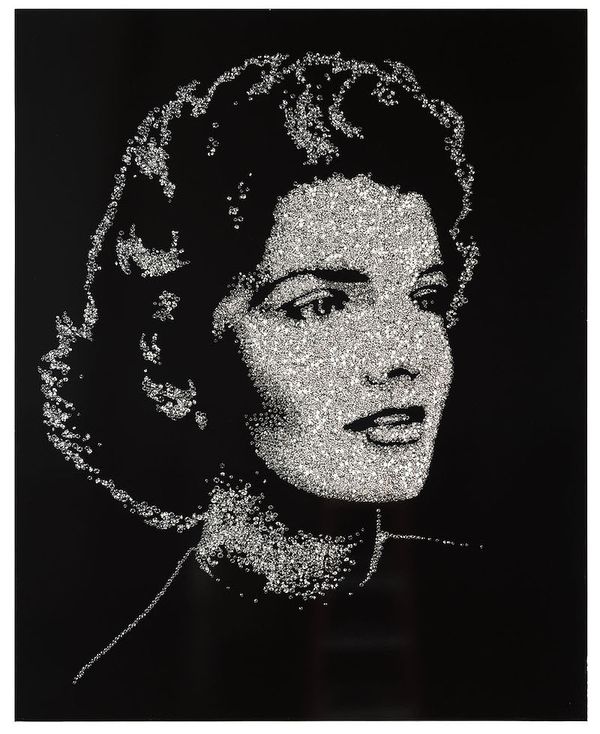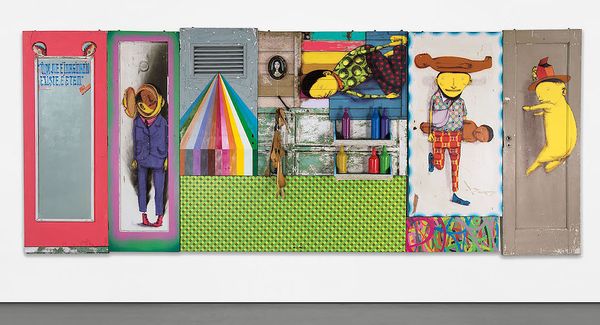OSGEMEOS, Dentro do arco-iris, é assim (Within the Rainbow), 2010. Estimate $150,000 - 200,000. 20th Century and Contemporary Art Day Sale.
Serge Tiroche co-founded the Tiroche DeLeon Collection in 2011, and with a unique combination of intuition and extensive knowledge, he was able to amass one of the strongest contemporary art collections of works by Latin American artists.
Over the last ten years, Serge Tiroche has been travelling to Latin America, acquiring remarkable works of art, guided not only by his own keen taste, talent, and timing, but also by relying on a very meticulous process that involves continuous research and a deep understanding of the history of the continent, as well as in the development of personal relationships with artists, galleries and other cultural institutions. Through the creation of this well-respected and influential collection, Tiroche has also provided broader exposure for these artists, introducing their work to a larger, international audience.

Abraham Cruzvillegas, Autorretrato ciego regresando a la cordura entre gritos y sombrerazos en la plaza Taksim, 2013. Estimate $30,000 - 40,000. 20th Century and Contemporary Art Day Sale.
Representing an expansive and diverse selection of the most influential artists actively working in Latin America today, this important collection includes esteemed names such as Abraham Cruzvillegas, OSGEMEOS, Adrián Villar Rojas, Leandro Erlich, and Vik Muniz. The selection of works currently on offer from the collection is representative of both well-established and more emerging artists. Working with everyday objects in a manner that intersects distinct movements like Pop art and Arte Povera, these varied works heighten our perception and elicit an appreciation of our own experiences. If there is one point around which these artists may be brought together, it is that each of them approaches their work as a field of exploration, suggesting that art offers a unique way of discovering our relationship to the world, a theme that resonates today perhaps more than ever.
Abraham Cruzvillegas’ work is characterized by the use of discarded materials that are handled, recycled and reassembled in a process of accumulating and reordering everyday objects. The recontextualization and act of bringing new meanings through intuition and improvisation, link his practice to his hometown of Ajusco, Mexico City, where the traditional way of building involves adding or resolving issues with salvaged materials from everyday life. Cruzvillegas has adopted the term "Autoconstruccion" (Self- construction) to name his organic and collaborative way of working. In this way, he reflects on informal versus formal composition, and the organic apprehension and fractures of concepts of the universal with knowledge of philosophy and anthropology.

OSGEMEOS, Dentro do arco-iris, é assim (Within the Rainbow) (detail), 2010. Estimate $150,000 - 200,000. 20th Century and Contemporary Art Day Sale.
Autorretrato ciego regresando a la cordura entre gritos y sombrerazos en la plaza Taksim, 2013, belongs to one of the well-known series autorretratos ciegos (blind self-portraits), where the artist gathers large groups of diverse papers accumulated in his day-to-day activity: napkins, envelopes, images and articles from newspapers and magazines, receipts as well as bus, subway, train, tram and plane tickets, etc. In the present work, these various mementos of daily life are unified by color as the artist applied a coat of beige paint to each of the elements obscuring the specific information and then pinning them geometrically to the wall. This action of creating a harmonious abstract structure out of disorganized scraps of daily life proposes a new reflection on identity.
Camisas, 2012, by the Argentinian artist, Leandro Erlich, consists of two shelves that initially appear to contain ten perfectly folded white shirts, however when approached are revealed to be made of ceramic rather than fabric, some of which are cracked or in pieces. Throughout his career, Erlich has depicted daily situations transformed by an illusion that requires a paradigm shift on behalf of viewers. The viewer is immersed in a fictional world in which nothing is what it seems and everything that responded to an order is disordered. Therefore, in this conceptual movement of Borgian references, it allows the emergence of new questions through an immersive visual language. As the artist and theorist Luis Camnitzer explains in the catalog of the artist’s retrospective exhibition at MALBA, Buenos Aires in 2019, "Leandro's work challenges the word "order" both in its authority and in its organization. It does it insidiously...because it does not mess up, as would be the obvious, but rather it substitutes. The authority seems to be maintained and the organization also. Thus, after all, the impossible seems possible, the absurd becomes rational, and the known is questioned until it touches the unknown."

Adrián Villar Rojas, Sick of Goodbyes, 2011. Estimate $30,000 - 50,000. 20th Century and Contemporary Art Day Sale.
Adrián Villar Rojas is a key figure in a younger generation of Argentinian artists. He imagines everyday life to be populated by fictional characters with mythical and literary references, within virtual and digital worlds. With his creation of a new, iconographic corpus from the beginning of his career, such as the devastated pool seen in Sick of Goodbyes, 2011, his spaces are in a state of ruin and his figures, colossal and timeless, cannot be immediately characterized as belonging to a distant past or a near future. He creates immersive environments of a post-human world that require the viewer to take an attentive look at the details in order to realize, the process of production, and thus to reflect on our own material decay. Image, process and matter constitute a complex rhetoric and critical thinking in all his approaches. Likewise, the world of the pictorial image references a state between the intelligible and the strange. Moving between abstraction and figuration, the work of the Brazilian artist, Vik Muniz proposes the creation of worlds where the appearance of things is re-signified in new images that he photographs. Muniz’s Pictures of Garbage, 2008-2011, is arguably his best-known series and was the subject of an award-winning documentary called Waste Land, 2010.

Vik Muniz, Jackie (Pictures of Diamonds), 2005. Estimate $80,000 - 120,000. 20th Century and Contemporary Art Day Sale.
As an emphatic reading of the harsh inequalities faced by the "catadores" (rag-pickers) in Jardim Gramacho—the world’s largest dump site—the present work, criticizes our unbridled consumerism by contrasting the contents of the image with artworks from the cannon of western culture. Muniz portrays seven "catadores" working in the yard on the outskirts of Rio de Janeiro through a trompe l'oeil technique using actual garbage from the yard. The meticulous technique highlights and contrasts beauty with waste. Similarly, in Jackie (Pictures of Diamonds), 2005, Muniz highlights a remarkable figure, while at the same time questioning the legitimacy of the diamond trade that goes hand-in-hand with the image.
OSGEMEOS’s Dentro do arcoiris, e assim (within the Rainbow), 2010 is an iconic large-scale work that the artists assembled through the partial recycling of earlier works that were exhibited at Deitch Projects, New York in 2008 and then in Vertigem in 2010—a four-stop traveling exhibition in Brazil.
Inhabited by the artists’ signature yellow figures, that arise from the idiosyncrasy of the Brazilian streets, where they first began their artistic journey, as well as hip-hop culture and American graffiti from the 1990s, the present work was the centerpiece of their mid-career retrospective at the Institute of Contemporary Art in Boston in 2012. The inclusion of everyday objects in this work are a nod to Pop art and constructivism, which marks the seminal development of the new direction in their most recent works.
Discover More from 20th Century and Contemporary Art >

Recommended Reading
The Intimacy of Marlene Dumas >
